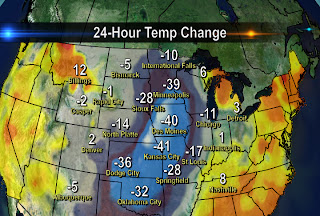The entire Midwest has just seen a radical change in our weather pattern! Record high temperatures fell off a cliff when Arctic air blasted down from Canada. If you haven't had any luck seeing big mature deer lately, this cold surge might be just what the deer doctor ordered.
 |
| The 24 hour temperature shift behind the front is 40 degrees colder. |
|
Warm temperatures are a major rut suppressor. Anyone whose seen a rutting buck knows their bodies are already under enough stress. They relentlessly travel, seeking and chasing does, challenging and defending rights to breed, and breeding. It's a lot of work! When you add high temps into the equations it slows a rutting buck down like we would if we were working outside in a Heat Advisory.
 |
| Veteran's Day Temperatures Tumbled in Des Moines, Iowa. |
Mature deer lose a significant percentage of their body mass from constantly burning calories. When the temperatures are warm, a rutting buck simply has to cut down his movement especially during the hottest part of the day (1-4pm). From my experience it seems 50F is a good baseline temperature between seeing good deer movement and poor movement. When the mercury climbs above 50, deer movement begins to become more limited. When the mercury falls, especially below freezing, deer movement picks up.
 |
| Temperatures for November 10th through November 16th. |
|
There are a lot of other factors too. Human pressure trumps temperatures and can easily be the best way to turn a buck nocturnal. Hunters predictably traveling to their one hunting spot can easily turn a shot at a trophy shoulder mount and deer sticks into a nocturnal trail camera model. Deer encounter and sense human pressure which can send them into survival mode and tarnish your hopes for tagging that deer. Being mobile and interactively scouting with your bow works quite well during this phase of the rut. Not to mention the thrill of taking one from the ground is hard to match!
Buck to doe ratios can also become a substantial rut suppressor. If competition is low because the numbers of does to bucks is lopsided in favor of the females, visible rut activity may be significantly reduced in your area.
 |
| The Rutting Full Moon was October 29th, 2012. |
Moon phase, farmer/land-use pressures and other environmental factors like habitat degradation or major weather systems with heavy snow or rain all can influence deer patterns and overall activity levels.
This cold surge has removed temperature concerns from the equation! The Whitetail rut has been active for a few weeks now and peak breeding has likely already passed in your area or will this week. Get out and do some hunting in this cold weather if you can, post-rut is on the horizon.
Good luck!




No comments:
Post a Comment